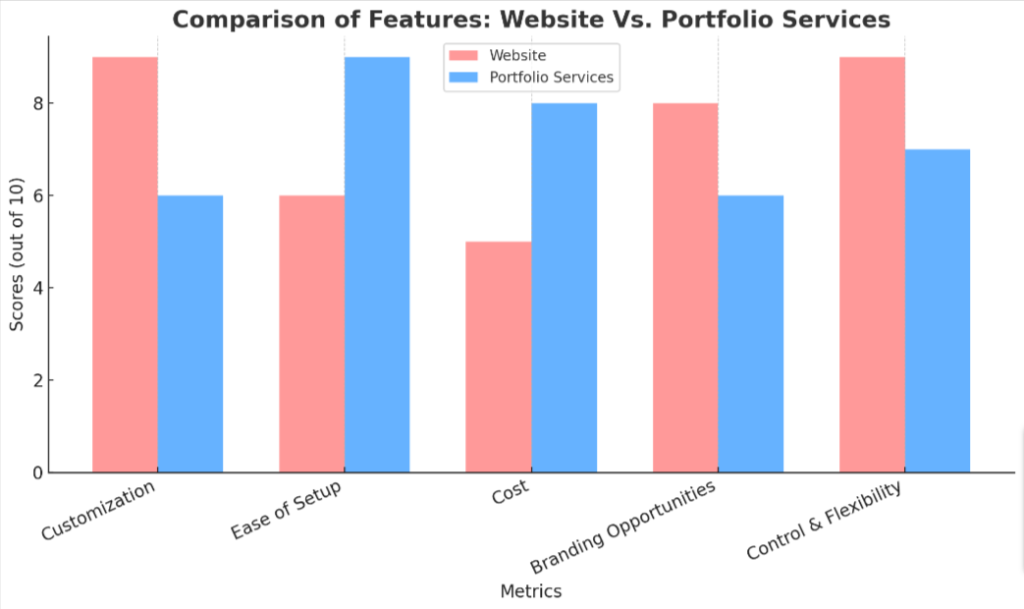Website or Portfolio Service: Making the Best Choice for Your Work
Deciding where to showcase your work online can be a daunting task. Did you know that 38% of people won’t engage with unattractive content? This blog will assist you in dissecting the advantages and disadvantages of owning a website versus using portfolio services.
Stick around, it’s time to make that decision easier!
Key Takeaways
- Having a website provides customization and control, allowing you to create a unique online presence tailored to your needs.
- Websites project a professional image and can be optimized for search engines, increasing visibility and attracting organic traffic.
- Portfolio services offer ease of use with ready – made templates but have limited customization options and branding limitations.
Pros and Cons of Having a Website
Having a website offers customization and control, allowing you to create a unique online presence tailored to your specific needs. It also projects a more professional image compared to using portfolio services.
Additionally, websites can be optimized for search engines, increasing the chances of attracting organic traffic and improving visibility.
Customization and control
Having your own website gives you an unparalleled level of customization and control. You get to express your unique style, picking the exact layout, colors, fonts, and images that align with your brand or personal taste.
Beyond just aesthetics, you can also structure the user experience on your site to match exactly how visitors will interact with your content. Plus, if you want to add a blog or e-commerce functionality later on, it’s all in your hands.
This freedom isn’t usually possible with portfolio services due to their preset templates and features.
Professional image
Having a full-fledged website as your professional storefront can significantly enhance your business’s image. Corporate leaders, artists, and freelancers alike rely on this platform to showcase their work.
A professionally designed webpage subtly communicates commitment to quality and attention to detail.
In the digital world, first impressions are critical. With thousands of design options and customization features available in various website building platforms, businesses can create an impactful presence online.
Be it a slick eCommerce platform or an elegant artist’s portfolio; websites offer broader opportunities to display creativity with user experience in mind. This ultimately lends credibility, helping you stand out among competitors.
SEO optimization
SEO optimization involves fine-tuning your website to improve its ranking on search engines. This strategy significantly impacts the visibility of a site, affecting web traffic and conversions.
It’s vital for businesses looking to increase their online presence.
Effective SEO strategies include keyword research, link building, and content creation. These help crawlers understand the relevance of your page to specific queries, thus increasing organic search results.
A well-optimized site provides a better user experience leading to higher engagement rates.
Pros and Cons of Using Portfolio Services
Using portfolio services has its own advantages and disadvantages. They are easy to use with ready-made templates, but offer limited customization options and branding limitations.
Ease of use
Portfolio services offer a significant advantage in terms of ease of use. These platforms typically provide ready-made templates that make it simple to create and maintain your online portfolio.
You don’t need any technical skills or experience with web design. The user-friendly interface allows you to add, remove, and update content effortlessly. With just a few clicks, you can customize the layout of your portfolio and showcase your work in an organized manner.
This convenience makes portfolio services an attractive option for individuals who want a hassle-free way to create their online presence without the complexity of building and managing a website.
Ready-made templates
Ready-made templates are a key advantage of using portfolio services for creating your website. These templates provide you with pre-designed layouts and designs that can be easily customized to fit your needs.
They save you time and effort in designing the website from scratch, allowing you to quickly establish your online presence. With a variety of templates available, you can choose one that aligns with your brand image and desired aesthetic.
Whether you’re an artist showcasing your work or a small business promoting products, ready-made templates offer a convenient solution for creating an attractive and professional-looking website without the need for extensive design skills.
In addition, these templates are often designed with user experience in mind, ensuring that visitors have a seamless browsing experience on your site. The layouts are optimized for different devices, making them mobile-friendly and responsive across various screen sizes.
This is crucial as more people access websites through their smartphones or tablets.
Limited customization options
Portfolio services offer ready-made templates and designs that may limit your ability to fully customize your website. This means you might not be able to personalize the look and feel of your site to match your brand or unique style.
While these pre-designed templates can make it easier and quicker to set up a portfolio, they may restrict your creativity when it comes to creating a truly distinctive online presence.
Branding limitations
Portfolio services may have some branding limitations when compared to having a website. With portfolio services, you are often limited in terms of customizing the design and layout of your portfolio.
This means that it may be more challenging to create a unique and personalized brand image. Additionally, portfolio services may require you to display their logo or include links back to their platform on your portfolio, which can detract from your own branding efforts.
It’s important to consider these branding limitations when deciding between a website and using portfolio services for showcasing your work or business.
Factors to Consider When Choosing a Platform
Consider the purpose of your website/portfolio, your budget, technical skills, and long-term goals.

Purpose of the website/portfolio
Your website or portfolio serves as a digital representation of your brand, showcasing your work, skills, and expertise. It acts as a platform to attract potential clients, employers, or collaborators who are looking for the specific services you offer.
Whether you are an artist looking to display your artwork or a photographer seeking bookings for events, having a purpose-driven website or portfolio helps you establish credibility and professionalism in the online space.
It allows you to highlight your unique value proposition and stand out from the competition in order to achieve your goals.
Budget
Considering your budget is an important factor when choosing between a website and portfolio services. Building a custom website can be more expensive upfront, as it may require hiring a web developer or purchasing hosting services.
On the other hand, using portfolio services often comes with subscription fees or charges for additional features. Take into account your financial resources and determine how much you are willing to invest in your online presence, keeping in mind that ongoing maintenance and updates may also incur costs.
Technical skills
Having the necessary technical skills is an important factor to consider when choosing a platform for your website or portfolio. If you are confident in your ability to navigate and customize website builders or content management systems, then opting for a website may be the best choice for you.
On the other hand, if you have limited technical skills and prefer a simpler approach, using portfolio services with ready-made templates can make building and managing your online presence much easier.
Ultimately, it’s important to assess your own abilities and comfort level with technology before deciding on a platform.
Long-term goals
Considering your long-term goals is crucial when choosing between a website and portfolio services. Think about where you want to take your online presence in the future. If you have plans to expand and grow, having a website gives you more flexibility and control over your content, design, and functionality.
On the other hand, if you’re looking for a simple platform to showcase your work without worrying about technical aspects or updates, portfolio services might be a better fit. Ultimately, aligning your long-term goals with the capabilities of each platform will help determine which one suits your needs best.
Conclusion
When deciding between a website and portfolio services, it’s important to weigh the pros and cons of each. A website offers customization and control, allowing you to create a professional image and optimize for search engines.
On the other hand, portfolio services offer ease of use with ready-made templates, but have limited customization options and branding limitations. Consider your purpose, budget, technical skills, and long-term goals when choosing the right platform for your needs.

